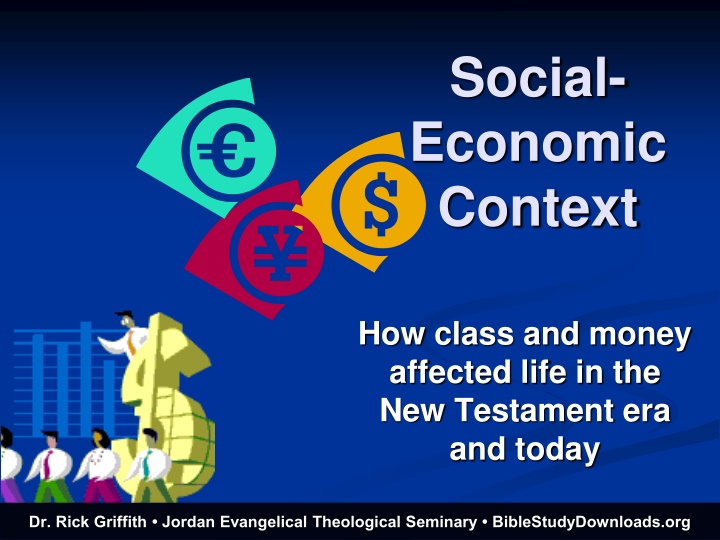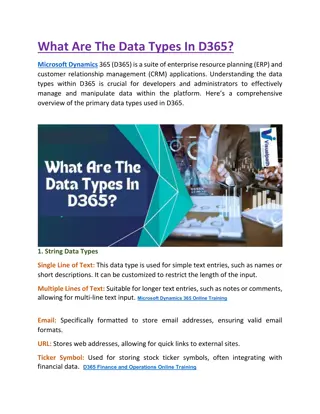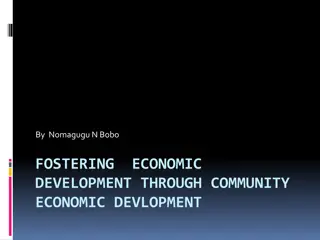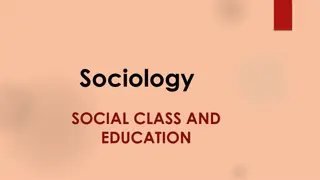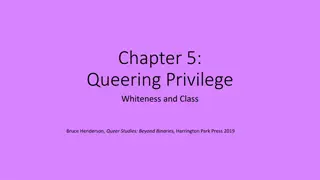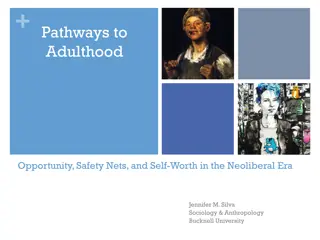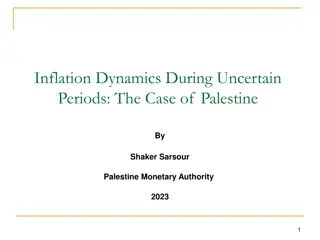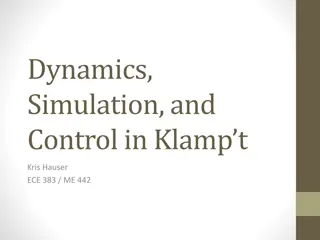Economic Class Dynamics: Then and Now
Explore how money and class distinctions impacted life in the New Testament era and its relevance to contemporary society. The economic and social context of the Intertestamental Period sheds light on the disparities that existed then and their parallels in today's world.
Download Presentation

Please find below an Image/Link to download the presentation.
The content on the website is provided AS IS for your information and personal use only. It may not be sold, licensed, or shared on other websites without obtaining consent from the author.If you encounter any issues during the download, it is possible that the publisher has removed the file from their server.
You are allowed to download the files provided on this website for personal or commercial use, subject to the condition that they are used lawfully. All files are the property of their respective owners.
The content on the website is provided AS IS for your information and personal use only. It may not be sold, licensed, or shared on other websites without obtaining consent from the author.
E N D
Presentation Transcript
Social- Economic Context How class and money affected life in the New Testament era and today Dr. Rick Griffith Jordan Evangelical Theological Seminary BibleStudyDownloads.org
REVIEW: Intertestamental Period 1.This time period is also called the "_____" years. 2.One prominent family of this period was the _________ or __________. 3.The biggest challenge of secularization came from ______ culture. 4.T or F The "synagogue" is another name for the Temple.
REVIEW: Intertestamental Period 1.This time period is also called the "silent" years. 2.One prominent family of this period was the _________ or __________. 3.The biggest challenge of secularization came from ______ culture. 4.T or F The "synagogue" is another name for the Temple.
REVIEW: Intertestamental Period REVIEW: Intertestamental Period 1.This time period is also called the "silent" years. 2.One prominent family of this period was the Maccabees or Hasmoneans. 3.The biggest challenge of secularization came from ______ culture. 4.T or F The "synagogue" is another name for the Temple.
REVIEW: Intertestamental Period REVIEW: Intertestamental Period 1.This time period is also called the "silent" years. 2.One prominent family of this period was the Maccabees or Hasmoneans. 3.The biggest challenge of secularization came from Greek culture. 4.T or F The "synagogue" is another name for the Temple.
REVIEW: Intertestamental Period REVIEW: Intertestamental Period 1.This time period is also called the "silent" years. 2.One prominent family of this period was the Maccabees or Hasmoneans. 3.The biggest challenge of secularization came from Greek culture. 4.T or F The "synagogue" is another name for the Temple.
97 Social-Economic Context Population Languages Social Life
97 The NT World was Agrarian How would this affect: social structure, economy, and religious life?
97 Population of Empire = 55 Million Roman Empire Gentiles: 51 million Jews: 4 million
97 Population Groupings 60 50 40 Millions of People Citizens Non-Citizens Slaves Slaves Citizens Non-Citizens 30 20 10 0
Ethnic Populations of Israel 97 GalileeBatanea 40% 60% Gentiles Samaria Decapolis Gentiles Jews Perea Gentiles Jews Judea Idumea Arabia
97 Languages of the Empire Roman Empire Languages of the Empire Latin Greek Aramaic Hebrew
Latin: The Legal Language 23 Letters from Latium, Italy Numerals Based on Letters V = 5 C = 100 Quiz: Add these numbers: 88 LXXXVIII + 12 + XII 100 Answer: C
What does this say? MR PIGS MR NOT PIGS! OSAR CM PENS? LIB MR PIGS! Them are pigs Them are not pigs! Oh, yes they are! See them pens? Well I'll be! Them are pigs! Peter had an accent too!
97 Aramaic in Palestine Batanea Galilee "After a little while the bystanders came up and said to Peter, 'Certainly you too are one of them, for your accent betrays you.'" Decapolis Samaria Perea (Matthew 26:73) Judea Idumea Arabia
98 Hebrew in Palestine? Previously thought virtually unknown Recent studies say it was common
97 Languages of the Empire Roman Empire Languages of the Empire Aramaic Hebrew
98 Social Life Social Classes Roman Social Institutions Ethnic Groups Racial Prejudice Next Class Session
98 Four Roman Social Classes Equestrians (Patricians) Plebians Freedman Slaves
98 Equestrians (Patricians) Social Classes Turret Bedroom Bathroom Country Garden Storeroom Massage Room Garden Dining Room Atrium Beach Main Courtyard Guest Room
98 The Caracalla: Roman Luxury
A ROMAN DINNER PARTY THREE-COURSE BANQUET If you are invited Three- Course Banquet FIRST COURSE (gustatio starter) Freshly caught shellfish and oysters drizzled in garlic sauce, snails, cooked in their shells, sliced boiled eggs, lettuce, olives, figs, and honeyed wine SECOND COURSE (caput cenae main dish) Remove outdoor shoes Whole roast boar, filled with sausages and egg yolks, followed by stuffed dormice in honey, peacocks, fish and shellfish, sauces, cabbage, and scented wine It is good THIRD COURSE (secunda mensa dessert) Stay for games Fresh figs, pears, apples, grapes, olives, nuts, jam, pastries and sweet wine
Praetorian Standard The standard of the Praetorian Guard differs from most it has portraits of the emperor inside its disks. 98 Officer in charge The centurion marches at the head of his troops. The sideways crest across his helmet is a sign of his rank. Social Classes Wooden staff, called vitis, used to punish disobedient soldiers Centurions were Wealthy Metal leg guards called greaves Hobnailed leather boots called caliga
98 Wealthy Roman Women
Romans loved the races A DAY AT THE RACES
98 Equestrian High Priests Annas Caiaphas Sanhedrin Annas & Caiaphas both conducted illegal trials of Jesus
98 Social Classes Equestrians Plebians Freedman Slaves TIME OFF: Stop at a bar for a rest and a tasty hot snack.
98 Regular Plebian Priests Wore Plain White Linen
98 Plebian Artisans (Blacksmith)
98 Jewish Carpenters were Plebians
98 Freedman were former slaves of various classes Equestrians Social Classes Plebians Freedman "But one day some men from the Synagogue of Freed Slaves [Freedman, NIV], as it was called, started to debate with [Stephen]." Slaves (Acts 6:9 NTL)
98 Freedman were also called "friends" Equestrians Social Classes Plebians "There is no greater love than to lay down one's life for one's friends. 14You are my friends if you do what I command. 15I no longer call you slaves, because a master doesn't confide in his slaves. Now you are my friends, since I have told you everything the Father told me" (John 15:13-15). Freedman Slaves
98 Social Classes New Slaves Just In Equestrians (Patricians) Plebians Freedman Slaves
Features of Slavery during Roman Empire Entry into Slavery Roman military conquests Natural reproduction Rescue from exposure International trade Piracy Sold themselves into slavery for various reasons
Slavery in the Roman Empire "The slave was absolutely at his master's disposal; for the smallest offence he might be scourged, mutilated, crucified, [or] thrown to the wild beasts" (J. B. Lightfoot, Saint Paul's Epistles to the Colossians and to Philemon, 321)
Image5 Features of Slavery during Roman Empire When Romans conquered the Mediterranean, they took millions of slaves to Italy. The Italians were major importers of slaves with slaves accounting for 40 percent of the population! Features of slavery during Roman Laws which promoted or restricted the Roman slave system: Slave sold in Roman slave trade Lex Poetelia (326 BC) Lex Aelia Sentia (AD 4) Lex Fufia Caninia (AD 2) Lex lunia Sorbana
Roman Social Institutions A Jewish boy celebrates his bar mitzvah, reading from the Torah scroll, at the Western Wall in Jerusalem. 98 Koinonia Voluntary associations were clubs that anyone could join unlike the Jewish ones closed to outsiders
Roman Social Institutions 98 Koinonia Roman voluntary associations
Roman Social Institutions 98 Koinonia The house church movement today is reviving some of these NT concepts Koinonia Small Groups
98 Members of the City Community could appeal to the Forum of Rome
98 Citizenship referred to being a citizen of either Rome or Israel Acts 22:28 (NAU) "The commander answered, 'I acquired this citizenship with a large sum of money.' And Paul said, 'But I was actually born a citizen.'" Eph. 2:12 (NAU) "Remember that you [Gentiles] were at that time separate from Christ, excluded from the commonwealth [citizenship NLT] of Israel, and strangers to the covenants of promise, having no hope and without God in the world."
Characteristics of the Household Community 99 1. Same Biological Source on Same Estate 2. Hierarchy of Authority 3. Freedmen and Slaves 4. Common Religion Ronald D. Runyon, "Principles & Methods of Household Evangelism," BibSac 142 (Jan-Mar 1985), 64-74
99 Household Implications 1.Household conversions 2.Unity of body of Christ 3.Flexible structure Ronald D. Runyon, "Principles & Methods of Household Evangelism," BibSac 142 (Jan-Mar 1985), 64-74
The church is an organism more than an organization
99 Household Implications 1.Household conversions 2.Unity of body of Christ 3.Flexible structure 4.Relationships Ronald D. Runyon, "Principles & Methods of Household Evangelism," BibSac 142 (Jan-Mar 1985), 64-74
People lack relationships today
99 Household Implications 1.Household conversions 2.Unity of body of Christ 3.Flexible structure 4.Relationships 5.Church meeting place 6.Social variety 7.Testing ground Ronald D. Runyon, "Principles & Methods of Household Evangelism," BibSac 142 (Jan-Mar 1985), 64-74
99 Households Tested Faithfulness Ronald D. Runyon, "Principles & Methods of Household Evangelism," BibSac 142 (Jan-Mar 1985), 64-74
